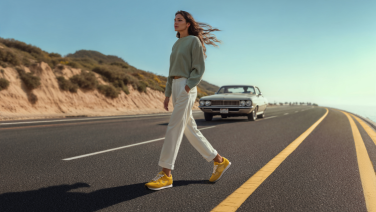Ingenious anti-blister tricks for more comfort when hiking
Pressure points, friction, sore feet – regular hikers know the struggle. Discover proven tips to get your feet ready for your next hike.
You're planning your next hike – and you have one goal: to set off and arrive as carefree as possible. What's the last thing you need? That's right: painful blisters on your feet. Unfortunately, they are a common companion on longer tours – especially if you're wearing the wrong equipment or haven't prepared well.
To make sure that doesn't happen to you, we've put together some practical anti-blister tips that come from real-life experience and have proven themselves on many hiking trails. You don't need any high-tech equipment – just a little know-how and preparation.

Good footwear – the basis for blister-free hiking
It sounds logical, but is often underestimated: you can't do without the right hiking boots. They should have a grippy tread, be waterproof and keep your feet comfortable. Particularly comfortable are hiking boots with merino lining, such as the Wool Cross X Alpine or the Merino Leather Alpine. These ensure breathability and temperature regulation – ideal for long tours.
Another practical feature is that these models are so waterproof that you can wade through a stream without getting your feet wet. And dry feet mean less friction and less chance of blisters.
Socks: The underrated factor in hiking
Just as important as the right shoes are the right hiking socks. It's worth investing in merino socks, as they are not only breathable but also odour-neutral, even after many kilometres.
Particularly clever: the anatomical cut of high-quality hiking socks ensures that no creases form – one of the main causes of blisters.
Another extra tip: the two-layer sock trick. Wear a thin sock under your normal hiking socks. The first layer acts like a ‘second skin’ and significantly reduces friction – especially on long or new routes.
Preparation is everything: break in your shoes and find the right size
One of the most common beginner's mistakes is breaking in new hiking boots on a long hike. Not a good idea. Hiking boots need time to break in – and so do your feet. So wear them a few times around the house first: when shopping, walking the dog or just going for a stroll. This reduces the risk of pressure points and gives you a feel for how they fit.
And speaking of fit: the right size is crucial. Shoes that are too tight cause pressure, while shoes that are too big allow your feet to slip. Both can lead to blisters. If you are unsure, it is better to order two sizes and try them on thoroughly. Be sure to use the size charts.
Natural strengthening & targeted prevention: walking barefoot, double layers & taping
There are a few simple but effective measures you can take to make your feet more robust or protect particularly sensitive areas:
-
Walk barefoot: as often as possible! This strengthens the muscles in your feet, toughens your skin and promotes the formation of a natural layer of calluses. This makes your skin more resistant and less sensitive to friction.
- Wear two layers of socks: As described above, a thin base layer of socks worn under your hiking socks helps to reduce friction between your skin and your shoes.
- Taping: If you know that certain areas (e.g. the balls of your feet or your toes) are prone to irritation, you can tape them before setting off as a precaution. It is important that the tape is smooth and wrinkle-free so that it does not create any additional friction points.
Blisters cannot always be avoided 100% – but with the right tricks and a little preparation, you can significantly reduce the risk. Anyone who consciously addresses the issue will notice that it's the little things that make the difference. Good footwear, high-quality socks, the right size and a little training for your feet – and you'll be well equipped for your next tour.
After all, when you don't have to think about your sore feet while you're out and about, you can focus on what really matters: enjoying the view, breathing deeply and simply being outdoors.
































